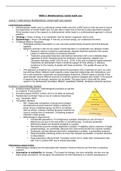Samenvatting
4.3 Severe Mental Illness in Urban Context Samenvatting Week 4
Samenvatting van alle te lezen literatuur van week 4 en colleges van het vak 4.3 Severe Mental Illness in Urban Context van de master Klinische Psychologie aan de Erasmus Universiteit Rotterdam (EUR). Behaald tentamencijfer: 8.0. Literatuur is in het Nederlands samengevat en colleges zijn voornamel...
[Meer zien]




